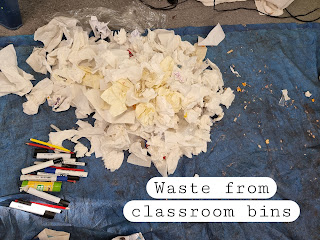Today, as part of our Moana Inquiry Year Four looked at how we can be kaitiakitanga (guardians) of our moana and how our actions can make a difference. We watched
Why is plastic so bad video and this inspirational video too
Hope StoriesWe wondered if we were part of the plastic problem, so we looked in our lunchboxes. Room 6 had 12 litterfree lunches out of 25. Room 5 had 14 out of 26. Well done! Room had 8 litterfree lunchboxes but sadly DOUBLE the total number of litter items compared to the other classes. We are going to run another promotion later in the year to see how much we can improve.
Room 5 had a total of 25 litter pieces in our lunchboxes. That would be 125 pieces of litter a week and 5000 pieces of litter in a school year. And over 100000 pieces schoolwide per year!
Wow it sure adds up! If every class is the same that's 120 000 pieces of litter each year generated by Sunnyhills School children's lunchboxes. Goodness! Sadly lots of this plastic litter escapes lunchboxes and is blown into the sea.
We had a prizedraw for the litterfreelunch children to say well done for making the extra effort. THANK YOU Paradice Ice Skating for the prize vouchers!
We wondered how we could make a difference with a big group brainstorm. Here's our ideas:
Touma - pick up rubbish
Kayla - pick up rubbish in the ocean
Lily - bring a litterfree lunch
Mukundi - make "pick up rubbish" posters
Indigo - talk to our parents about using less plastic
Kayla - make a video about how we can save the Hauraki Gulf
Bridie - convince the government to stop allowing plastic
Kayla - convince the supermarkets to not use plastic
Eesa - use less plastic. Use cardboard and paper
Ambrose - Bring a litterfree lunchbox everyday
Brayden - replace ship packets with carboard
Kayla - make crafts out of plastic
Emma - use old things
Luca - try to never use plastic again
Harry - try melting the plastic down so you can reuse it.
Mila - try to convince your parents to pack a litterfree lunch
Zachary - use less plastic
Nathan - go to the ocean each week and take the plastic out
Mila - use less Gladwrap
Richie - pick up rubbish everyday
Saane - pick up rubbish
Hunter - gather a group and get them to pick up rubbish
Nicolas - get some posters and share them
Ivy - have a litterfree lunch everyday
Renee - make agame of picking up rubbish and give out prizes
Rooms 6 & 5 set about put some of their ideas into action.
After lunch Room 4 collected all the rubbish bins around school for our biannual Waste Audit. We are monitoring how effective our waste reduction schemes are. Standby for the results tomorrow!


















































